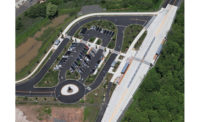Best Airports/Transit Project










The $155-million Sound Transit U230 Tunnel project is located in the most densely populated neighborhood in the northwestern U.S. Developed to create a vital connection between downtown Seattle and the Capitol Hill neighborhood, the 3,800-ft-long, 18-ft, 10-in.-dia twin tunnels are on a steep downhill grade and entirely on a curve.
Tunneling crossed under 32 structures and multiple utilities, many of which are more than 80 years old. The tunneled portion also included two crossings of Interstate 5, which carries approximately 250,000 vehicles per day through downtown Seattle. These crossings were carried out with only 13.5 ft of cover.
The majority of the alignment in the crossing location was on a very tight curve with a radius of only 550 ft. Only 0.18% of the tunnel was not on a curve and 29% of the tunneling was on both a horizontal and a vertical curve.
The geologic history of the project site presented extremely variable soil conditions. At least seven different advance-retreat cycles of continental glaciers during the Pleistocene era caused the stratigraphy along the tunnel alignment to be quite complex. Multiple erosion and deposition cycles occurred during the time that these materials were at the surface. Crews faced flowing ground, hard glacial till and numerous glacial-erratic boulders. More than 300,000 cu yd of material were excavated from the tunnel alignment.
The project was completed on time and on budget despite the fact that a differing site condition encountered during the early work added four months to the schedule for excavation of the shaft. The team mitigated the delay through continuous and coordinated efforts to perform multiple tasks concurrently. Concrete pours were started in the excavation before the excavation was complete.
The size and complexity of the concrete pours were increased by a factor of up to five, requiring one pour of 5,500 cu yd. Tunnel boring machine assembly was also started before completion of the concrete placement in the bottom of the excavation.
In addition to the twin tunnels, the scope included five cross passages, two low-point sump alcoves and a station box excavation of approximately 560 ft long, 74 ft wide and 75 ft deep with approximately 9.8 ft of reinforced concrete invert.
Prior to the project, public transportation by bus could take 15 to 20 minutes on local streets. The new U230 tunnel allows transportation of passengers from the downtown Westlake Station to the center of Capitol Hill in approximately three minutes.
Sound Transit U230 Tunnels (CHS to PSST), Seattle
Key Players
Owner Central Puget Sound Transit Authority
Construction Management START, a Joint Venture of CH2M Hill and Jacobs
Design Support NTP, a Joint Venture of Jacobs Associates, HNTB and AECOM
Contractor JCM U-Link, a Joint Venture of Jay Dee Contractors Inc., Coluccio Construction and Michels Tunneling






